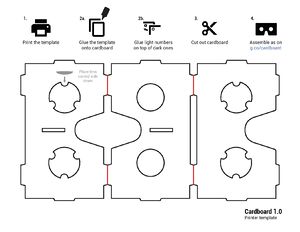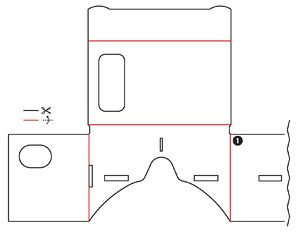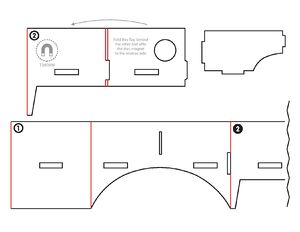Difference between revisions of "Google Cardboard"
Xinreality (talk | contribs) |
Xinreality (talk | contribs) |
||
| Line 20: | Line 20: | ||
===Instructions=== | ===Instructions=== | ||
| + | The following are 3 images. Please print the images then glue the images onto cardboard. Next cut out the cardboard based on the images and construct the device. | ||
[[File:google cardboard instruction1.jpg|300px]] [[File:google cardboard instruction2.jpg|300px]] [[File:google cardboard instruction3.jpg|300px]] | [[File:google cardboard instruction1.jpg|300px]] [[File:google cardboard instruction2.jpg|300px]] [[File:google cardboard instruction3.jpg|300px]] | ||
==Apps== | ==Apps== | ||
Revision as of 05:33, 12 February 2015
Google Cardboard, announced in Google I/O on June 25, 2014, is a cardboard cut-out smartphone mount. With a smartphone inserted, Google Cardboard allows the user to have a Virtual Reality experience by holding it close to his or her face.
While Google Cardboard requires a smartphone with stereoscopic display software, this simple and affordable device is constructed with lenses, a magnet, a piece of hook-and-loop fastener and a rubber band. With no official manufacturer, Google has listed the schematics and instructions for the device on its website. Users can either construct one themselves or purchase them from a number of unofficial vendors.
Apps such as immersive games and concert experiences are available in the Google Play store. Developers familiar with OpenGL can use Cardboard SDK for Android to rapidly create VR apps for the device.
Hardware
Parts
Cardboard - Corrugated cardboard sheet, preferably E Flute (corrugated cardboard comes in a variety of thicknesses called "flutes"), available at many art supply stores and online . For best results, you should look for strong, thin cardboard (sturdy shoe box rather than moving box). Minimum size: 8.75in (22cm) by 22in (56cm), and 0.06in (1.5mm) thickness.
2 Lenses - This is the trickiest component. Lenses that have a 45mm focal distance might work. Biconvex lenses work best because they prevent distortion around the edges.
2 Magnets - One neodymium ring magnet and one ceramic disk magnet. Approximate size: 0.75in (19mm) diameter and 0.12in (3mm) thickness.
2 Velcro - Two strips of regular strength adhesive-backed velcro. Approximate size: 0.75in (20mm) by 1.25in (30mm).
1 Rubberband - One rubber band, to prevent the phone from sliding out. Minimum length of 3.2in (8cm).
1 NFC Tag (Optional) - One sticker NFC tag. Program it with the URL cardboard://v1.0.0
Instructions
The following are 3 images. Please print the images then glue the images onto cardboard. Next cut out the cardboard based on the images and construct the device.


